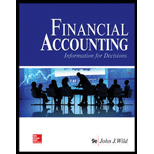
Loose Leaf for Financial Accounting: Information for Decisions
9th Edition
ISBN: 9781260158762
Author: John J Wild
Publisher: McGraw-Hill Education
expand_more
expand_more
format_list_bulleted
Question
Chapter 6, Problem 12E
Summary Introduction
Introduction:
To determine: The bank reconciliation of the given statements is to be determined.
Expert Solution & Answer
Want to see the full answer?
Check out a sample textbook solution
Students have asked these similar questions
What accounting principle requires using the same accounting methods and principles from one period to another?a) Materiality principleb) Consistency principlec) Matching principled) Revenue recognition principle
Q: The double-entry bookkeeping system ensures that:a) Revenues are recorded on the left side of the accounting equationb) Expenses are recorded on the right side of the accounting equationc) Assets always equal liabilitiesd) Every transaction is recorded with equal debits and credits
Answer? ? Financial accounting
Chapter 6 Solutions
Loose Leaf for Financial Accounting: Information for Decisions
Ch. 6 - List the seven braod principles of internal...Ch. 6 - Prob. 2DQCh. 6 - Prob. 3DQCh. 6 - Prob. 4DQCh. 6 - Prob. 5DQCh. 6 - Prob. 6DQCh. 6 - Prob. 7DQCh. 6 - Prob. 8DQCh. 6 - Prob. 9DQCh. 6 - Prob. 10DQ
Ch. 6 - Refer to Google’s financial statements in Appendix...Ch. 6 - Prob. 12DQCh. 6 - Prob. 13DQCh. 6 - Prob. 1QSCh. 6 - Prob. 2QSCh. 6 - Prob. 3QSCh. 6 - Prob. 4QSCh. 6 - Prob. 5QSCh. 6 - Prob. 6QSCh. 6 - Prob. 7QSCh. 6 - Prob. 8QSCh. 6 - Prob. 9QSCh. 6 - Prob. 10QSCh. 6 - Prob. 11QSCh. 6 - Prob. 1ECh. 6 - Prob. 2ECh. 6 - Prob. 3ECh. 6 - Prob. 4ECh. 6 - Prob. 5ECh. 6 - Prob. 6ECh. 6 - Prob. 7ECh. 6 - Prob. 8ECh. 6 - Prob. 9ECh. 6 - Prob. 10ECh. 6 - Prob. 11ECh. 6 - Prob. 12ECh. 6 - Prob. 13ECh. 6 - Prob. 14ECh. 6 - Prob. 15ECh. 6 - Prob. 1PSACh. 6 - Prob. 2PSACh. 6 - Prob. 3PSACh. 6 - Prob. 4PSACh. 6 - Prob. 5PSACh. 6 - Prob. 1PSBCh. 6 - Prob. 2PSBCh. 6 - Prob. 3PSBCh. 6 - Prob. 4PSBCh. 6 - Prob. 5PSBCh. 6 - Prob. 6SPCh. 6 - Prob. 1GLPCh. 6 - Prob. 1FSACh. 6 - Prob. 2FSACh. 6 - Prob. 3FSACh. 6 - Prob. 1BTNCh. 6 - Assume you are a business consultant. The owner of...Ch. 6 - Prob. 4BTNCh. 6 - Review the opening feature of this chapter that...Ch. 6 - Prob. 6BTN
Knowledge Booster
Similar questions
- 1.25.12-PacificCoast Hotel's laundry department uses load optimization tracking. Each washer has 25kg capacity. Today's loads averaged: Morning 22kg, Afternoon 19kg,Evening 23kg. What is the unutilized capacity percentage?arrow_forwardGeneral accountingarrow_forwardWhat is the book value?arrow_forward
arrow_back_ios
SEE MORE QUESTIONS
arrow_forward_ios
Recommended textbooks for you
 Survey of Accounting (Accounting I)AccountingISBN:9781305961883Author:Carl WarrenPublisher:Cengage Learning
Survey of Accounting (Accounting I)AccountingISBN:9781305961883Author:Carl WarrenPublisher:Cengage Learning College Accounting (Book Only): A Career ApproachAccountingISBN:9781337280570Author:Scott, Cathy J.Publisher:South-Western College PubPrinciples of Accounting Volume 1AccountingISBN:9781947172685Author:OpenStaxPublisher:OpenStax College
College Accounting (Book Only): A Career ApproachAccountingISBN:9781337280570Author:Scott, Cathy J.Publisher:South-Western College PubPrinciples of Accounting Volume 1AccountingISBN:9781947172685Author:OpenStaxPublisher:OpenStax College- Century 21 Accounting Multicolumn JournalAccountingISBN:9781337679503Author:GilbertsonPublisher:Cengage
 Financial And Managerial AccountingAccountingISBN:9781337902663Author:WARREN, Carl S.Publisher:Cengage Learning,
Financial And Managerial AccountingAccountingISBN:9781337902663Author:WARREN, Carl S.Publisher:Cengage Learning,

Survey of Accounting (Accounting I)
Accounting
ISBN:9781305961883
Author:Carl Warren
Publisher:Cengage Learning

College Accounting (Book Only): A Career Approach
Accounting
ISBN:9781337280570
Author:Scott, Cathy J.
Publisher:South-Western College Pub

Principles of Accounting Volume 1
Accounting
ISBN:9781947172685
Author:OpenStax
Publisher:OpenStax College

Century 21 Accounting Multicolumn Journal
Accounting
ISBN:9781337679503
Author:Gilbertson
Publisher:Cengage

Financial And Managerial Accounting
Accounting
ISBN:9781337902663
Author:WARREN, Carl S.
Publisher:Cengage Learning,
